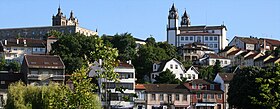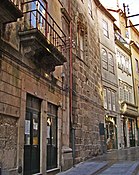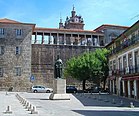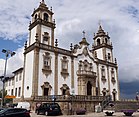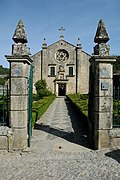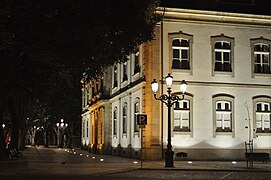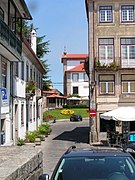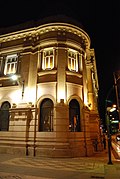Viseu
Viseu | |
|---|---|
|
Clockwise: View of Viseu; historic center; Igreja da Misericórdia; Praça D. Duarte; Viseu Cathedral. | |
|
UTC±00:00 (WET) | |
| • Summer (DST) | UTC+01:00 (WEST) |
| Local holiday | September 21 |
| Website | www |
Viseu (Portuguese pronunciation:
Viseu is a regional economic hub with a strong wine industry and is the seat of the international conglomerate
History
The origins of the city of Viseu date back to the pre-Roman period, with its name being reconstructed from the indigenous word 'Vissaîegobor' as *Vissaium, perhaps with a latinised suffix.[2]
With its
Viseu is associated with Viriathus, since it is thought[by whom?] that the Lusitanian hero may have been born in this region. After the Roman occupation of the peninsula, under the Visigoths, the settlement was elevated to the status of city and to the seat of a diocese by at least the 6th century.
Middle Ages
The origins of Viseu extend to proto-history, when migrating groups settled the territory, including the Celts and Lusitanians. Roman colonists settled in these territories during eras of prosperity and peace, leading eventually to Suebic, Gothic and Muslim cultures.[3] The Suebic peoples, by the middle of the 6th century, had already established a community, with a bishop that existed at the suffrage of Roman Catholic Archdiocese of Braga.[3] With the arrival of North African Muslims, the Visigoths escaped the territory to the distant mountains of Asturias.[3]
The lands of Viseu frequently switched hands between the Christians and
During
During the
The city became part of a fiefdom, when Prince Henry the Navigator, son of King John I of Portugal, was made Duke of Viseu, in 1415.
In 1475,
In 1513, King Manuel I of Portugal renewed the charter of Viseu and a series of works were taken on throughout the city, with the opening of the first square of the city, the Rossio.
In the 19th century, a new Municipal Palace was built in the Rossio, significantly altering the flow of the city, moving it away from the medieval center to newer parts of the city.
Geography

Viseu is approximately 50 km (31 mi) East of the Atlantic Ocean. Surrounded by a number of mountains – Leomil, Montemuro, Lapa, Arada, Estrela and Caramulo – the tops of which are covered with thick layers of snow in Winter time, the district is crossed by a network of rivers and streamlets.
The city of Viseu has an almost central position in relation to the District lying on the so-called Viseu Plateau (in Portuguese Planalto de Viseu). It is surrounded by a mountainous system constituted to the north by the Leonil, Montemuro, and Lapa hills, to the northeast by the Arado hills, to the south and southeast by the Serra da Estrela and the Lousã hills and to the west by the Caramulo hills.
The Municipality is characterized by an irregular surface with altitudes ranging between 400 and 700 metres (1,300 and 2,300 feet). With rough terrain, it has numerous water courses. These are found in three basins: the Vouga, the
Climate
Situated in a zone of transition, the concelho has several micro-climates. The Serra do Caramulo, located to the west of the city, plays an important role in climatic terms by lessening the influences of the western air masses (although the Mondego River's basin makes the penetration easier). Consequently, Viseu's climate is characterized by the existence of high temperature extremes, with cold and wet winters and hot and dry summers.
Viseu has a
| Climate data for Viseu, 1981-2010 normals and extremes, altitude: 443 m (1,453 ft) | |||||||||||||
|---|---|---|---|---|---|---|---|---|---|---|---|---|---|
| Month | Jan | Feb | Mar | Apr | May | Jun | Jul | Aug | Sep | Oct | Nov | Dec | Year |
| Record high °C (°F) | 20.7 (69.3) |
22.6 (72.7) |
27.6 (81.7) |
30.3 (86.5) |
33.0 (91.4) |
39.0 (102.2) |
40.5 (104.9) |
40.4 (104.7) |
39.6 (103.3) |
31.2 (88.2) |
27.3 (81.1) |
22.5 (72.5) |
40.5 (104.9) |
| Mean daily maximum °C (°F) | 11.9 (53.4) |
13.8 (56.8) |
16.9 (62.4) |
17.6 (63.7) |
20.6 (69.1) |
26.2 (79.2) |
29.6 (85.3) |
29.6 (85.3) |
26.1 (79.0) |
20.1 (68.2) |
15.1 (59.2) |
12.7 (54.9) |
20.0 (68.0) |
| Daily mean °C (°F) | 7.1 (44.8) |
8.6 (47.5) |
11.0 (51.8) |
11.9 (53.4) |
14.7 (58.5) |
19.0 (66.2) |
21.7 (71.1) |
21.6 (70.9) |
19.0 (66.2) |
14.7 (58.5) |
10.6 (51.1) |
8.5 (47.3) |
14.0 (57.3) |
| Mean daily minimum °C (°F) | 2.2 (36.0) |
3.3 (37.9) |
5.2 (41.4) |
6.2 (43.2) |
8.8 (47.8) |
11.7 (53.1) |
13.8 (56.8) |
13.5 (56.3) |
11.9 (53.4) |
9.1 (48.4) |
6.0 (42.8) |
4.2 (39.6) |
8.0 (46.4) |
| Record low °C (°F) | −6.6 (20.1) |
−7.3 (18.9) |
−5.4 (22.3) |
−2.6 (27.3) |
−0.5 (31.1) |
2.6 (36.7) |
5.3 (41.5) |
6.0 (42.8) |
3.0 (37.4) |
0.7 (33.3) |
−3.5 (25.7) |
−5.0 (23.0) |
−7.3 (18.9) |
| Average precipitation mm (inches) | 153.2 (6.03) |
105.6 (4.16) |
79.0 (3.11) |
113.6 (4.47) |
103.0 (4.06) |
35.2 (1.39) |
19.2 (0.76) |
17.8 (0.70) |
66.0 (2.60) |
147.0 (5.79) |
155.5 (6.12) |
203.4 (8.01) |
1,198.5 (47.2) |
| Source: Instituto Português do Mar e da Atmosfera[6][7] | |||||||||||||
| Climate data for Viseu Airport, 1981-2010 normals and extremes, altitude: 644 m (2,113 ft) | |||||||||||||
|---|---|---|---|---|---|---|---|---|---|---|---|---|---|
| Month | Jan | Feb | Mar | Apr | May | Jun | Jul | Aug | Sep | Oct | Nov | Dec | Year |
| Record high °C (°F) | 19.5 (67.1) |
21.3 (70.3) |
25.8 (78.4) |
28.3 (82.9) |
33.2 (91.8) |
35.4 (95.7) |
39.4 (102.9) |
38.6 (101.5) |
37.0 (98.6) |
29.4 (84.9) |
23.4 (74.1) |
19.0 (66.2) |
39.4 (102.9) |
| Mean daily maximum °C (°F) | 10.4 (50.7) |
12.3 (54.1) |
15.5 (59.9) |
16.4 (61.5) |
19.4 (66.9) |
24.4 (75.9) |
27.6 (81.7) |
28.0 (82.4) |
23.8 (74.8) |
18.4 (65.1) |
13.3 (55.9) |
10.7 (51.3) |
18.4 (65.0) |
| Daily mean °C (°F) | 7.1 (44.8) |
8.4 (47.1) |
11.0 (51.8) |
11.8 (53.2) |
14.5 (58.1) |
18.7 (65.7) |
21.1 (70.0) |
21.6 (70.9) |
18.5 (65.3) |
14.5 (58.1) |
10.0 (50.0) |
7.7 (45.9) |
13.7 (56.7) |
| Mean daily minimum °C (°F) | 3.8 (38.8) |
4.5 (40.1) |
6.4 (43.5) |
7.1 (44.8) |
9.6 (49.3) |
13.0 (55.4) |
14.5 (58.1) |
15.3 (59.5) |
13.2 (55.8) |
10.7 (51.3) |
6.7 (44.1) |
4.6 (40.3) |
9.1 (48.4) |
| Record low °C (°F) | −4.2 (24.4) |
−4.5 (23.9) |
−6.8 (19.8) |
−1.2 (29.8) |
1.8 (35.2) |
5.6 (42.1) |
7.3 (45.1) |
7.6 (45.7) |
5.8 (42.4) |
2.2 (36.0) |
−0.9 (30.4) |
−2.9 (26.8) |
−6.8 (19.8) |
| Average precipitation mm (inches) | 183.2 (7.21) |
103.5 (4.07) |
98.2 (3.87) |
118.7 (4.67) |
98.2 (3.87) |
37.6 (1.48) |
19.5 (0.77) |
28.5 (1.12) |
60.4 (2.38) |
173.7 (6.84) |
161.8 (6.37) |
201.0 (7.91) |
1,284.3 (50.56) |
| Source: Instituto Português do Mar e da Atmosfera[8] | |||||||||||||
| Climate data for Viseu, 1971-2000 normals and extremes | |||||||||||||
|---|---|---|---|---|---|---|---|---|---|---|---|---|---|
| Month | Jan | Feb | Mar | Apr | May | Jun | Jul | Aug | Sep | Oct | Nov | Dec | Year |
| Record high °C (°F) | 20.0 (68.0) |
22.5 (72.5) |
27.4 (81.3) |
30.3 (86.5) |
33.0 (91.4) |
39.0 (102.2) |
40.5 (104.9) |
40.4 (104.7) |
39.6 (103.3) |
31.2 (88.2) |
24.6 (76.3) |
22.5 (72.5) |
40.5 (104.9) |
| Mean daily maximum °C (°F) | 11.6 (52.9) |
13.2 (55.8) |
15.9 (60.6) |
17.1 (62.8) |
20.2 (68.4) |
25.4 (77.7) |
29.2 (84.6) |
29.2 (84.6) |
25.9 (78.6) |
19.8 (67.6) |
15.0 (59.0) |
12.4 (54.3) |
19.6 (67.2) |
| Daily mean °C (°F) | 6.9 (44.4) |
8.4 (47.1) |
10.3 (50.5) |
11.5 (52.7) |
14.3 (57.7) |
18.4 (65.1) |
21.4 (70.5) |
21.1 (70.0) |
18.8 (65.8) |
14.2 (57.6) |
10.2 (50.4) |
8.1 (46.6) |
13.6 (56.5) |
| Mean daily minimum °C (°F) | 2.2 (36.0) |
3.5 (38.3) |
4.6 (40.3) |
6.0 (42.8) |
8.5 (47.3) |
11.5 (52.7) |
13.5 (56.3) |
13.0 (55.4) |
11.7 (53.1) |
8.5 (47.3) |
5.3 (41.5) |
3.8 (38.8) |
7.7 (45.8) |
| Record low °C (°F) | −6.6 (20.1) |
−7.3 (18.9) |
−5.4 (22.3) |
−3.8 (25.2) |
−0.5 (31.1) |
2.0 (35.6) |
5.3 (41.5) |
6.0 (42.8) |
2.0 (35.6) |
−2.8 (27.0) |
−3.6 (25.5) |
−5.0 (23.0) |
−7.3 (18.9) |
| Average precipitation mm (inches) | 155.7 (6.13) |
133.6 (5.26) |
74.8 (2.94) |
105.2 (4.14) |
95.9 (3.78) |
46.1 (1.81) |
19.2 (0.76) |
17.9 (0.70) |
57.0 (2.24) |
133.2 (5.24) |
135.9 (5.35) |
195.4 (7.69) |
1,169.9 (46.04) |
| Source: Instituto Português do Mar e da Atmosfera[9] | |||||||||||||
Human geography
| Year | Pop. | ±% |
|---|---|---|
| 1801 | 33,699 | — |
| 1849 | 36,049 | +7.0% |
| 1900 | 54,047 | +49.9% |
| 1930 | 61,140 | +13.1% |
| 1960 | 79,890 | +30.7% |
| 1981 | 83,261 | +4.2% |
| 1991 | 83,601 | +0.4% |
| 2001 | 93,501 | +11.8% |
| 2011 | 99,274 | +6.2% |
Administratively, the municipality is divided into 25
- Abraveses
- Barreiros e Cepões
- Boa Aldeia, Farminhão e Torredeita
- Bodiosa
- Calde
- Campo
- Cavernães
- Cota
- Couto de Baixo e Couto de Cima
- Faíl e Vila Chã de Sá
- Fragosela
- Lordosa
- Mundão
- Orgens
- Povolide
- Ranhados
- Repeses e São Salvador
- Ribafeita
- Rio de Loba
- Santos Evos
- São Cipriano e Vil de Souto
- São João de Lourosa
- São Pedro de France
- Silgueiros
- Viseu
Due to migration in the 1960s, Viseu suffered a great decline in its population. After the end of the Portuguese Colonial War (1961–1974), with the return of refugees from the Portuguese African colonies that achieved independence, and resulting economic and demographic growth, starting at the end of the 1970s, the municipality increased its population by about 10 percent, giving it an estimated population of 83,261 people. Afterwards, a stagnation set in, confirmed by the 1991 census which showed a population of 83,601.
International relations
As of 2023, Viseu is
 Abidjan, Ivory Coast
Abidjan, Ivory Coast Arezzo, Italy
Arezzo, Italy Campinas, Brazil
Campinas, Brazil Cantagalo, São Tomé and Príncipe
Cantagalo, São Tomé and Príncipe Elvas, Portugal
Elvas, Portugal Haskovo, Bulgaria
Haskovo, Bulgaria Lublin, Poland
Lublin, Poland Marly-le-Roi, France
Marly-le-Roi, France Matola, Mozambique
Matola, Mozambique Rio de Janeiro, Brazil
Rio de Janeiro, Brazil São Filipe, Cape Verde
São Filipe, Cape Verde Taiyuan, China
Taiyuan, China
Economy
The city and the region are famous for its wine (
Transportation
The city of Viseu has a bus network – MUV – which operates several lines within the entire municipality and a recently installed funicular connecting the lower city with the upper city. The A25 motorway (formerly called IP5) connects Viseu to the seaport of Aveiro and Guarda and then on to Salamanca in Spain. The IP3 and A24, connecting Coimbra with Chaves on the Spanish border, cross Viseu from south to north. Until the nineteen eighties Viseu had railway connections with the coast, but these were closed.
Viseu is now one of the largest cities in Europe without a railway connection. Once it was connected to Aveiro (via the
The municipality has an airfield – the
Education
Viseu is the location of the state-run
There are three secondary education (the Portuguese equivalent of High School) establishments: the Escola Secundária de Viriato, Escola Secundária Alves Martins and Escola Secundária Emídio Navarro.
Gallery
-
Cathedral of Viseu
-
São João da Tarouca convent
-
Viriato Theatre, Portugal
-
Town hall of Viseu
-
Towers and façade of the Cathedral
-
Interior of Viseu Cathedral
-
Viseu, Portugal
-
Remains of the city wall.
-
Altar of Igreja da Misericórdia.
-
View of Viseu
-
Viseu's Forum
-
Palácio do Gelo, Viseu
-
Bank of Portugal
-
Town centre of Viseu
Notable citizens

- Edward, King of Portugal (1391–1438), known as Duarte, King of Portugal, 1433 to 1438
- Grão Vasco, one of the principal Portuguese Renaissancepainters
- João de Barros (ca.1496 – 1570) historian, famous for his Décadas da Ásia, a history of the Portuguese in India, Asia, and southeast Africa.[12]
- Antonio Thomas (ca.1520 – 1590s) a marine and conquistador in service of the Spanish crown.
- Society of Jesus, missionary to India
- Beatriz Pinheiro (1872–1922) a writer and a pacifist concerned to improve the rights of women.
- Judite Teixeira (1880-1959) a writer of three books of poetry and a book of short stories
- Carlos de Liz-Texeira Branquinho (1902–1973) a Portuguese diplomat, saved the lives of 1,000 Jews in Nazi-occupied Hungary
- Manuel Maria Carrilho (born 1951) a philosopher, academic and politician; Minister of Culture, 1995 to 2000
- Álvaro Santos Pereira (born 1972) an economist, professor, writer and Govt. minister 2011/2013.
Sport

- marathon; the first Portuguese Olympic gold medalist
- Paulo Sousa (born 1970) is a former footballer, with 256 club caps and 51 for Portugal, later coach for ACF Fiorentina and the Poland national football team.
- Paulo Gomes (born 1975) a retired footballer with 296 club caps
- Bruno Madeira (born 1984) a footballer with over 360 club caps
- Fernando Ferreira (born 1986) a footballer with over 330 club caps
- Tiago Gonçalves (born 1986) a footballer with 247 caps with Académico de Viseu
- Fábio Santos (born 1988) footballer with over 300 club caps, plays for Académico de Viseu
- Neide Simões (born 1988) a women's football goalkeeper, played 60 times for the Portugal women's national football team
- Bruno Loureiro (born 1989) a footballer with over 270 club caps, plays for Académico de Viseu
- André Coelho (born 1993) a futsal player with 41 caps with the Portugal national futsal team
- Rui Miguel (born 1983) a footballer with over 330 club caps
- João Félix (born 1999) a football player with Atlético Madrid, with 51 caps for Portugal
- António Silva, footballer born 2003
References
- ^ "Portal do INE". www.ine.pt. Retrieved 2023-06-28.
- ISBN 978-84-9082-481-8
- ^ a b c d e f g h Câmara Municipal, ed. (2015), História (in Portuguese), Viseu, Portugal: Câmara Municipal de Viseu, archived from the original on 25 September 2015, retrieved 24 September 2015
- ^ Ferreira, Manuel dos Santos da Cerveira Pinto (2004). "A cidade de Lamengo durante o domínio árabe/islâmico" (PDF). O Douro no Garb al-Ândalus: A região de Lamego durante a presença árabe (thesis) (in Portuguese). p. 117. Retrieved 2 August 2018.
{{cite book}}:|work=ignored (help) - ^ "Viseu, Portugal Climate Summary". Weatherbase. Retrieved 21 March 2015.
- ^ a b c "Climate Normals for Viseu 1981-2010". IPMA. Retrieved 21 March 2015.
- ^ "Plano Municipal de Defesa da Floresta Contra Incêndios" (PDF). Mortágua Municipality. Retrieved 27 September 2021.
- IPMA. Retrieved 17 February 2022.
- ^ "Climate Normals - Viseu 1971-2000" (PDF). Portuguese Institute of Meteorology. Retrieved 29 August 2020.
- ^ Diário da República. "Law nr. 11-A/2013, pages 552 141-142" (PDF) (in Portuguese). Retrieved 5 August 2014.
- ^ Seara.com. "Cidades Geminadas". Câmara Municipal de Viseu (in Portuguese). Retrieved 2023-03-01.
- ^ Prestage, Edgar (1911). . Encyclopædia Britannica. Vol. 03 (11th ed.). p. 439.

